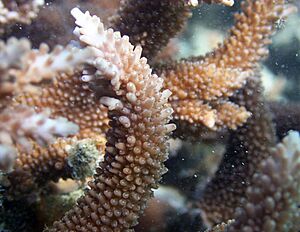Acropora acuminata facts for kids
Quick facts for kids Acropora acuminata |
|
|---|---|
 |
|
| Conservation status | |
| Scientific classification | |
| Synonyms | |
|
Acropora acuminata is a type of coral that lives in the ocean. It is found in many places, like Australia, the Red Sea, and parts of Asia. This coral lives on shallow coral reefs, usually about 5 to 20 meters deep. It was first described by a scientist named Addison Emery Verrill in 1864. This coral can be easily harmed by things like coral bleaching, crown-of-thorns sea stars, and people collecting it for aquariums.
What It Looks Like
This coral grows in colonies that often look like tables. They have branches that spread out flat and then get narrower at the ends. The small cups where the coral polyps live, called corallites, are hard to see on the flat branches. But on the branches that grow upwards, the corallites can be seen in two different shapes, including a large tube shape.
Acropora acuminata can be brown or a light blue color. It looks a bit like another coral called Acropora hoeksemai. The corallites on the sides of the branches have openings that look like nostrils or are oval-shaped. These openings usually do not touch each other.
Where It Lives and Why It's in Danger
Acropora acuminata is found in many warm ocean areas. These include the Red Sea, parts of Southeast Asia, Australia, Japan, and the western Pacific Ocean.
Scientists have listed this coral as a vulnerable species. This means its population is shrinking, and it could be in danger of disappearing. It is also protected by an international agreement called CITES.
There are several reasons why this coral is at risk:
- Coral Bleaching: When ocean temperatures get too warm, corals can get stressed. They lose the tiny algae that live inside them and give them color and food. This makes the coral turn white, which is called coral bleaching. If the water stays too warm, the coral can die.
- Climate Change: Changes in the Earth's climate affect ocean temperatures and chemistry. This makes it harder for corals to grow and survive.
- Human Activities: Things like pollution and damage from boats or fishing can harm coral reefs.
- Crown-of-Thorns Sea Stars: These are large starfish that eat coral. A lot of these starfish can cause serious damage to a coral reef.
- Collecting for Aquariums: Some people collect this coral to sell for home aquariums. This can reduce the number of corals in the wild.
- Diseases: Corals can also get diseases that make them sick and die.
How It Was Named
This coral was first described by a scientist named Addison Emery Verrill in 1864. He originally gave it the name Madrepora acuminata.


